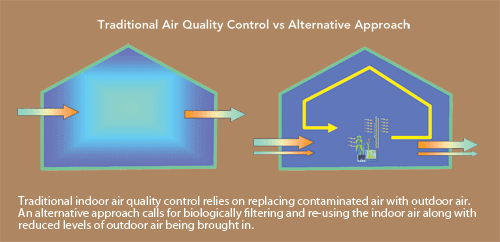Indoor Air Biofilters Deliver Clean Air Naturally
One of the most common contaminants to be addressed is volatile organic compounds (VOCs). In simplest terms, these are defined as carbon-, oxygen-, and hydrogen-containing compounds that are present as gases under normal atmospheric conditions—in other words are released as a gas from a liquid or solid. The U.S. Environmental Protection Agency (EPA) differentiates between those that are a concern and those which aren't. Naturally occurring compounds found in the environment such as metallic carbides or carbonates, and ammonium carbonate don't typically react, so they aren't included in the EPA's definition. A large number of others have been deemed to have negligible effects and as such aren't regulated. Many regulated VOCs are included on EPA's list because of the potential harm they can do to people at certain concentration levels. They are of particular relevance since they are used in literally thousands of manufactured products that go into the construction or operation of buildings. When these products emit VOCs into the air once installed inside a building, they can cause concentrations that are 5 to 10 times higher than would be found outside of the building. The common VOC-containing building products include things like paints, paint strippers, adhesives, wood preservatives, composite board stock, furniture, flooring, etc. It is common to restrict the use of materials containing VOCs by specifying “low VOC” and occasionally “no VOC” products may be available, but it is more likely that some VOC-containing products will make their way into virtually any building. Once a building is occupied then it becomes the operations that use aerosol sprays, cleansers, disinfectants, moth repellents, air fresheners, stored fuels, automotive products, or dry-cleaned clothing that can become contributing sources of VOCs. Other contributors can also include printers, photocopiers, paper products, computers, and the people themselves (perfumes, deodorants, and our natural scent). The impact of activities on IAQ is so great that buildings constructed with low-VOC material will eventually have the same IAQ as a typical construction.
One VOC that is a particular concern is formaldehyde which is a naturally occurring combination of hydrogen, oxygen, and carbon, but found to be irritating or even toxic to people. It is well known as a preservative in medical laboratories, as an embalming fluid, and as a sterilizer. Its primary use is in the production of resins and as a chemical intermediate for other products. Urea-formaldehyde (UF) and phenol formaldehyde (PF) resins are used in buildings as part of foam insulations and adhesives used for wall and floor finishes. In short, its use is very widespread in the construction industry and is also used in some paper products (www.cpsc.gov/cpscpub/pubs/725.pdf). As a result, green building standards and organizations focused on healthy indoor environments all tend to specifically address limiting the use of formaldehyde in addition to VOCs in general.
 |
|
Image courtesy of Nedlaw Living Walls Inc. |
Moving beyond VOCs, other contaminants include concentrations of particulate matter (i.e. dust) or detrimental gases such as carbon monoxide in the air. High concentrations of particulates cause irritation in human airways and can cause a wide range of respiratory ailments as a result. The presence of high concentrations of non-VOC gases can be toxic or even fatal in severe cases since the air could become starved of oxygen.
The traditional approach to remediating both the presence and the concentration of contaminants inside buildings is to exhaust out the contaminated air and replace it with outside air that is presumably fresher and cleaner. Historically, this was done by natural ventilation (operable windows, doors, or louvers) and many green building designs are looking to this option again. More common, however, is the use of HVAC equipment to move and treat the air in a building. Fans exhaust the indoor air out on one end, while drawing in and conditioning outdoor air on the other to distribute it throughout the building. Inserting air particle filters of one type or another into this process has been common for a long time, but the types and sophistication of those filters have increased in recent years to address indoor air quality concerns from contaminants. Of course, the cost of those filters has often increased as well. The purpose of the filters is to remove primarily particulate contaminants that are brought in from the outside, but also to help clean any air of particles that is re-circulated indoors. Building codes and standards promulgated by ASHRAE and others call for copious amounts of ventilation air to keep the occupants of a building healthy, even while sometimes jeopardizing the ability to optimize energy performance.
The U.S. Green Building Council's LEED® rating system even includes a provision for a construction indoor air quality management plan before occupancy that includes the option of “flushing out” the building with thousands of square feet of air for every square foot of space—a process that can take days or even weeks and temporarily drive up an energy bill notably. The LEED® rating system and other green building standards also call for a reduction in the presence of VOCs in building materials to begin with which is appropriate for construction and renovation projects where this can be specified and controlled. Nonetheless, since VOCs can come from so many other sources and can concentrate in indoor spaces at high levels, ventilation and filtration will likely always remain appropriate for contaminant removal.









